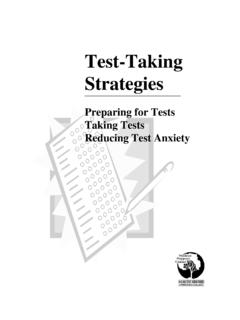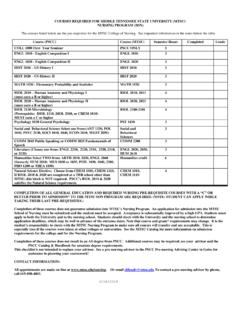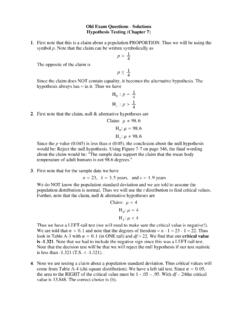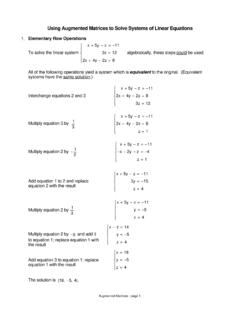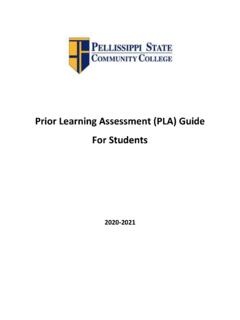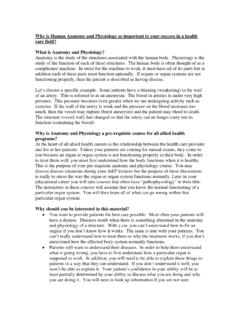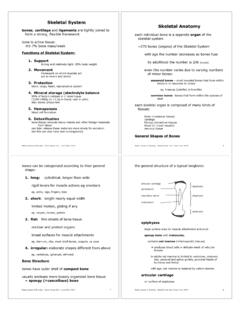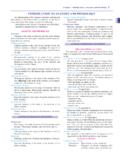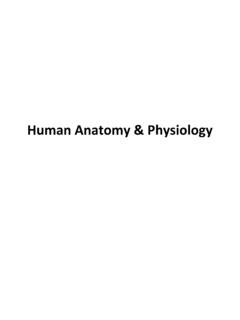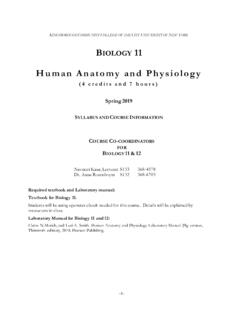Transcription of HUMAN ANATOMY & PHYSIOLOGY I BIOL 2010
1 PELLISSIPPI STATE COMMUNITY COLLEGE MASTER SYLLABUS HUMAN ANATOMY & PHYSIOLOGY I BIOL 2010 Class Hours: Credit Hours: Laboratory Hours: Revised: Spring 2015 Catalog Course Description: A study of basic biological chemistry, cellular structure and function (including cellular respiration, protein synthesis, and cell division); histology; and integumentary, skeletal, and nervous systems. Course includes three hours of lecture and laboratory applications each week. Entry Level Standards: Eligible for enrollment in ENGL 1010 and MATH 1530. Prerequisites: None Textbook(s) and Other Course Materials: Required: Textbook: Visual ANATOMY and PHYSIOLOGY , 2nd edition. Martini, et al, Pearson Publishers.
2 2015. Bundled with Applications Manual, Atlas, Getting Ready for A&P, Student Worksheets, and Access to Mastering A&P ISBN for Bundle: 10-0133942295; ~ ISBN and approximate cost for separate components: Textbook: 10-0321918940, ~$ (w/e-text); ~ (w/out e-text) Applications Manual: 10- 032197400X, ~$ Atlas: 10-080537373X, ~$27 Getting Ready for A&P: 10- 0321815688, ~$ Student Worksheets: 10-0321980735, ~$ Mastering A&P Access: 10- 0321963431, ~ (with e-text); ~$ (w/out e-text) All textbook and components available online at: Required: Laboratory manual: HUMAN ANATOMY and PHYSIOLOGY I Laboratory Manual, 4th ed. by Ron Bridges. Blue Door Publishing, 2015. ISBN-978-1-59984-629-3~$75 I.
3 Week/Unit/Topic Basis: Week Topic Chapter Lab Exercises 1 Chemistry of Life: Organic Cells and Cell Division 2 3 Lab Orientation/Safety (1) Body Language (2) Microscope (3) Cells (4) 2 Cell Metabolism Review Chapters 2-3, 23 23 (parts) 2,3, 23 Tissues and Membranes (6) 3 Test 1 (Chapters 2-3,23) Homeostasis Tissues & Membranes 2-3,23 1 4 Lab Practical 1 (1-6) 4 The Skin and Integument Bones/Skeletal Tissue 5 6 Integumentary (7) the Skeletal System. (8-9) 5 Test 2 (Chapters 1,4, 5) Bones/Skeletal Tissue 1,4,5 6 The Skeletal System. (8-9) 6 The Skeleton, Joints 7,8 Joints (11) Review for LP-2 7 Test 3 (Chapters 6-8) The Muscular System 6-8 9 Lab Practical 2 (7-11) 8 Muscle Tissues 9 Muscle Histology (12) Gross Muscle ANATOMY (13-14) 9 Muscle Tissues Nervous System Tissues 10 11 Gross Muscle ANATOMY (12-14) Review Muscles 10 Test 4 (Chapters 9-10) Nervous System Tissues (cont d) Brain and Cranial Nerves 9, 10 11 13 (1st half) Lab Practical 3 (12-14) 11 Brain and Cranial Nerves (cont d) Spinal Cord and Nerves 13 (1st half) 12 Nervous Tissues (15) Gross ANATOMY of the Nervous System and Reflexes (16,17) 12 Spinal Cord and Nerves (cont d) Sensory Basics Test 5 (Chapters 11-13) 12 13 (2nd half) The Senses (18-19)
4 Review for LP-4 (15-19) 13 Special Senses Autonomic Nervous System 15 14 Lab Practical 4 (15-19) 14 Test 6 (Chapters 13-15, plus review questions) 15 Final Exam Period II. Course Goals*: The course will: A. Know the anatomical terminology used in describing the whole body and selected organ systems. ( )* B. Understand the process of homeostasis. ( ) C. Understand the relationships between cells, tissues, organs, systems and the organism. ( , ) D. Understand the basic chemistry of the cell and the HUMAN body. ( ) E. Know the structure and function of cellular components. ( ) F. Understand the function of DNA and RNA in cellular processes. ( ) G. Know the ANATOMY (micro- and macro-) and understand the PHYSIOLOGY of the following systems: ( , , ) 1.
5 Integumentary 2. Skeletal 3. Muscular 4. Nervous H. Demonstrate effective, safe and ethical laboratory procedures. ( ) I. Use scientific methods to conduct an experiment, analyze anatomical specimens and perform physiological tests.( , ) J. Apply the principles of ANATOMY and PHYSIOLOGY to case study situations. ( , ) K. Use medical resources to aid in the analysis of medical data and determination of a diagnosis and treatment of some health problems. (V2,V3,V4) L. Function as member of a learning team. (V2, V3, V4) *Roman numerals after course objectives reference TBRs general education goals. III. Expected Student Learning Outcomes*: Students will be able to: 1. Use correct terminology and correct spelling to describe the HUMAN body in terms of regions, planes, sections, organs and systems.
6 (A)* 2. Explain the chemical composition of the cell including its primary elemental, inorganic and organic components. (C, D) 3. Describe cell structures and their functions and be able to identify the phases of the cell cycle (C, D, E) 4. Describe the functions and importance of DNA and RNA in maintaining cellular processes. (C, F) 5. Explain homeostasis and its significance to normal body functions and be able to identify the components of a homeostatic control system. (B,C) 6. Identify the anatomical components studied and explain the physiological mechanisms described in the following systems. Use correct terminology and spelling in the identification of all structures and functions. (B, G, H, I , J) a.
7 Integumentary System b. Skeletal System c. Muscular System d. Nervous System e. Special Senses 7. Demonstrate proper use of the microscope in the study of HUMAN cells and tissues. (E, H) 8. Demonstrate safe and ethical laboratory procedures. (H) 9. Evaluate laboratory data, develop and test hypotheses and write a coherent lab report that summarizes findings. (I, G). 10. Analyze case study situations and consult appropriate medical references in order to develop a diagnosis and treatment recommendation for conditions related to the systems studied. (G, J, K) 11. Function as an effective team member by participating in small group discussions and contributing to the completion of group assignments and projects (L).
8 *Capital letters after Expected Student Outcomes reference the course goals listed above. IV. Evaluation: A. Testing Procedures: The lecture portion of this course contains 825 points (75% of the total grade). Unit Tests: Each lecture unit will be evaluated using a 100 pt written test for a total of 600 pts. Unit tests will be a mix of multiple choice, short answer, listing and 1 or 2 essay questions. Some tests may contain diagrams for the student to draw and/or label. Lecture tests that are missed for a valid reason may be made up at the discretion of the instructor. Students must notify their instructor as to the reason for missing a test on the day the test is missed or as soon as possible. Failure to do this will make the reason invalid.
9 Make-up tests must be taken within a week of the original test date and will be of a different nature and will generally be harder than the regular tests. Lecture tests missed without a valid excuse will be given a score of Zero. Student Engagement Activities: In order to encourage student engagement with the course materials, each instructor will create various learning activities. These may include: pre-lecture assignments (quizzes, on-line activities, homework), in class participation (response systems, discussion points, presentations), critical thinking activities (case studies, journal reviews) and comprehensive assignments. Instructors will specify these activities, point values and due dates within their specific course syllabi.
10 B. Laboratory Expectations: The Laboratory portion of the grade covers a total of 275 points for determining letter grade, but a student must pass the lab with a 60% average in order to pass the course. If a student earns less than 60% in lab, they will fail the entire course. Lab Practicals: Each laboratory unit will be evaluated using a Lab Practical worth 50 points. Lab Practicals will consist of short answer questions that require identification of structures and processes explored during lab exercises. Each lab practical will cover material for that unit and up to 10 points worth of comprehensive material. If a student must miss a lab practical due to circumstances beyond their control, they may be able to take a make-up LP.

